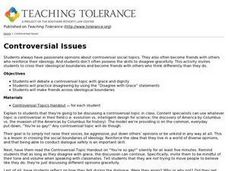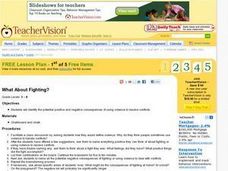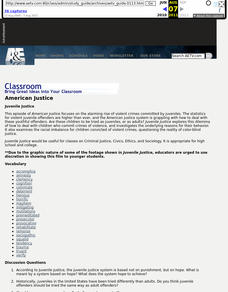C-SPAN
Wonder Girls - Advocating for Global Issues
Move over Wonder Woman ... here come the Wonder Girls! Using video clips of photographer Paola Gianturco talking about her work, pupils consider the life experiences of girls around the world, including places such as Tonga and India....
Curated OER
Lesson: Skin Fruit: Propaganda of the Deed
Art can express acts of injustice and move society to action. Upper graders analyze contemporary art relating to specific moments in history. They discuss propaganda, anarchy, sociology, and violence as activism. After researching and...
PBS
Making Change: Revolutionary Tactics of the Civil Rights Movement
The film American Revolutionary: The Evolution of Grace Lee Boggs introduces viewers to the differing philosophies of and strategies employed by 1960s civil rights leaders such as Malcolm X and Martin Luther King, Jr. and the debate over...
Bully Free Systems
Bully Free Lesson Plans—Fifth Grade
Two lessons take a look at bullying. Lesson one focuses on physical bullying. Scholars identify the bullying type's qualities, read short stories and answer comprehension questions. Lesson two offers advise on what to do as a bystander...
Curated OER
Kaffir Boy
Students explore the concepts of intolerance and racism in the autobiography Kaffir Boy written by Mark Mathabane. The instructional activity reveals the story's depiction of the terrible toll of apartheid on the lives of individuals.
Center for Civic Education
The Power of Nonviolence: Rosa Parks: A Quest for Equal Protection Under the Law
Teach young historians about the historical legacy of Rosa Parks with a multi-faceted lesson plan. Pupils follow stations and use journals to explore prominent events, analyze primary resource documents, and engage in interesting...
Curated OER
A Look at the History of Book Banning in America
Why do books end up on the banned book list? How do these banned books contribute to the literary canon? Start by showing the photo slide show, and discussing notably banned books. Then focus on some of the most popular objections:...
Curated OER
Lesson: Tlatelolco: Mexican Student Massacre 1968
The Massacre of Tlatelolco is the focus of a discussion-based lesson. Civil-minded learners consider the nature of student movements that have ended in violence based on over-reaction and government oppression. They discuss the social...
Curated OER
America's Civil Rights Movement, Activity Six
Pupils explore non-violence and investigate the difference between passive and active voice.
Curated OER
Effects of 11 September
Students discuss the 9/11 tragedy and the concept of misplaced blame and violence.
Curated OER
Six Lessons from Jena
Students have discussions on how to create a good school climate based on Jena Every School. Students discuss signs of trouble, school climate, bias incidences, forums for discussion, teachable moments, and bridging divisions in the school.
Curated OER
Controversial Issues
Hot topics are often engaging and can get heated. High School students engage in an academic discussion were they must learn to engage with a person holding a different view than their own. They practice discussing different opinions...
American Battlefield Trust
John Brown
How did the raid on Harper's Ferry contribute to the start of the Civil War? Curated for high school historians, the activity explains John Brown's contribution to the start of the Civil War by using violence to demand an end to slavery....
Curated OER
What About Fighting?
What are the positive and negative consequences of violence? Elementary and middle schoolers discuss how some see violence as the answer to resolving conflicts. They identify the positive and negative aspects to using violence, and ask...
Curated OER
Conflict Resolution
Students examine ways to resolve conflicts. In this conflict resolution instructional activity, students define conflict resolution and write down situations where leaders deal with conflicts. Students work in groups to create a...
Curated OER
American Justice: Juvenile Justice
Students watch a video that focuses on the alarming rise of violent crimes committed by juveniles. They see how the American justice system dealsl with these youthful offenders. They examine racial imbalance and color-blind justice.
University of the Desert
What Is Extremism?
By participating in discussions using prompts and statements provided in the instructional activity plan, learners identify the concept of extremism and consider what causes violent acts of extremism in the modern world.
US Institute of Peace
Responding to Conflict: Nonverbal Communication
What does your posture say about you? How can it affect the outcome of conflict resolution or negotiation? Show scholars the importance of nonverbal communication during the sixth in a series of 15 peacebuilding lessons. Learners work...
Curated OER
Fifty Years: From the Little Rock Nine to the Jena Six
Students discuss how the issues surrounding school integration have changed since the Little Rock Nine entered Central High School. They discuss the recent events in Jena, Louisiana. Students write a letter to a school administrator...
Curated OER
Creating Nonviolence: A Theatre of the Oppressed Approach to Things Fall Apart
Eleventh graders analyze Ahimsa and complete activities for nonviolence. In this nonviolence lesson, 11th graders define violence and relate it to their lives. Students adapt prose into a dialogue to act out and analyze the violence in...
Curated OER
The Popular Bully
Fifth graders investigate bullying and nonviolent ways to deal with bullies. In this conflict management lesson, 5th graders discover the definition for the word ahimsa and examine ways to incorporate that philosophy into their social...
Citizens Crime Commission of New York City
A Student’s Guide to Using Social Media Safely
While the kids in your class tap quickly on their electronic devices to stay in touch with their peers, they may not know the consequences of online social lives. Take them through a discussion about potential downfalls of a social media...
Missouri Department of Elementary
What Are Bullying and Harassment? Part 2
After reviewing notes from the previous lessons, small groups obtain a scenario card that describes a situation in which bullying is happening. Peers discuss the event and brainstorm two solutions using the STAR method then present their...
Missouri Department of Elementary
What Are Bullying And Harassment? Part 1
A brief survey begins a lesson that challenges scholars to answer the question, What is bullying? Learners discuss their answers and take notes, paying close attention to the types of bullying and roles people play. Pupils change their...
Other popular searches
- Violence in School
- Drugs and School Violence
- School Violence Prevention
- School Violence Week
- School Violence Worksheets
- School Violence Activities
- School Violence Awareness
- School Violence Indiana
- Promoting School Violence
- School Violence Iowa
- School Violence Mt. Vernon
- School Violence Mt Vernon

























